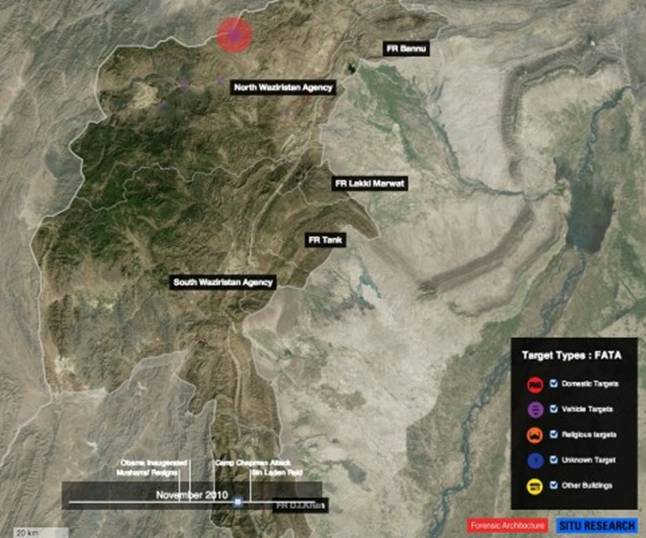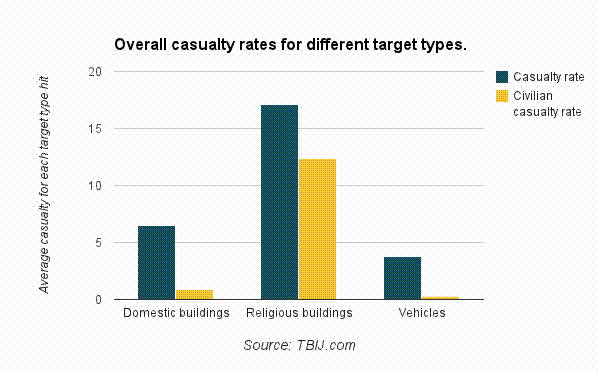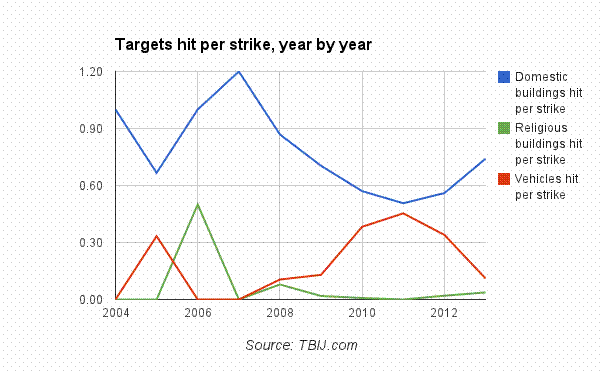Most US Drone Strikes In Pakistan Hit Homes, Finds A New Research
By Countercurrents
27 May, 2014
Countercurrents.org
Countercurrents.org
Domestic buildings have been hit by drone strikes more than any other type of target in the CIA's 10-year campaign in the tribal regions of northern Pakistan , finds a new research by The Bureau of Investigative Journalism (TBIJ).
The research finds: More than 61% (three-fifths) of all drone strikes in Pakistan targeted domestic buildings, with at least 132 houses destroyed in more than 380 strikes.
Its finding says: At least 222 civilians are estimated to be among the 1,500 or more persons killed in attacks on such buildings.
The report says:
“In the past 18 months, reports of civilian casualties in attacks on any targets have almost completely vanished, but historically almost one civilian was killed, on average, in attacks on houses.”
The research reveals that on average more civilians die when a building is targeted than when a vehicle is hit.
It says:
“At least a quarter of drone strikes in Pakistan hit vehicles – cars, motorbikes and pickup trucks, according to the research, and these attacks were significantly less likely than average to harm civilians. There have been no confirmed civilian casualties in strikes on vehicles at night.”
The researchers analyzed thousands of reports including contemporaneous media reports, witness testimonies and field investigations to gather the data on drone strikes in Pakistan 's Federally Administered Tribal Areas (FATA).

Pakistan's Federally Administered Tribal Areas (FATA)
The TBIJ's report by Alice K Ross and Jack Serle says:
“[A] new investigative project by the Bureau, Forensic Architecture, a research project based at London 's Goldsmiths University , and New York-based Situ Research, reveals that in Pakistan , domestic buildings continue to be the most frequent target of drone attacks.”
The project examines, for the first time, the types of target attacked in each drone strike – houses, vehicles or madrassas (religious schools) – and the time of day the attack took place.
The May 23, 2014 datelined report says:
“The CIA has consistently attacked houses throughout the 10-year campaign in Pakistan .
The time of an attack affects how many people – and how many civilians – are likely to die. Houses are twice as likely to be attacked at night compared with in the afternoon. Strikes that took place in the evening, when families likely to be at home and gathered together were particularly deadly.”
It cites Mansur Mahsud of the FATA Research Center . Mansur said: “Civilians usually avoid going out at night, because Taliban militants do not allow people to venture out of their homes at night without a valid reason.”
The Bureau's analysis finds that strikes on mosques and madrassas – religious schools – are the deadliest. At least eight strikes have hit such targets, killing over 17 people on average in each attack. At least 99 civilians have reportedly been killed in total.
The research reveals “a continued policy of targeting buildings throughout the CIA's campaign in Pakistan, despite an instruction in Afghanistan from the International Security Assistance Force (ISAF), the body which commands foreign operations in the country, that forces operate under the rule that ‘all compounds are assumed to house civilians unless proven to be clear'.”
The report says:
“The data shows the constantly shifting nature of the drone campaign, as the CIA and their targets adapt their tactics and behavior in a game of cat-and-mouse.
It is also possible that more civilians die in attacks on buildings than the reporting indicates. The Bureau's Naming the Dead project has found that the deaths of women are particularly vulnerable to being underreported.
Women and children
The report says:
“Women and children are more likely to stay indoors and therefore less likely to be seen ‘by [a] drone operator monitoring the structure,' says Susan Schuppli, senior research fellow at Forensic Architecture and the project coordinator. Women and children's ‘relative seclusion within private space makes them particularly vulnerable to becoming an unknown casualty when a strike occurs', she said.”
Everything was burned, pieces of flesh
Forensic Architecture interviewed a woman who survived a 2010 drone strike. It says:
“Originally from Germany , she had moved to Pakistan with her husband and his brother.
“She and a female friend were in the house one evening, when a group of men sitting in the courtyard was attacked. Her son, aged two, was outside the compound walls with his father, who had gone to smoke a cigarette.
“‘While we were eating, we heard a very loud bang. The house shook and a lot of earth fell on us from the roof… everything was covered in thick smoke,' she told researchers. In the courtyard, she saw ‘a big black hole where the rocket hit', where the men had been sitting to eat.
“Everything was burned, she continued. There were ‘pieces of cloth, and metal from the rocket … everywhere there were bits similar to the pieces of flesh of the three men, which were scattered everywhere.'
“Her brother-in-law was killed, along with at least four others.”
Mosques and madrassas
The report says:
“The figures for strikes on mosques and madrassas are skewed by a particularly bloody strike that hit a religious school in Chenegai, Bajaur on October 30 2006 that reportedly killing 81 people.
“But even excluding this incident, strikes on madrassas and mosques remain far more deadly – including to civilians – than those reported to have hit other targets. Excluding the Chenegai strike, the civilian casualty rate is nine times that of strikes on vehicles – 2.7 for each strike on average.
“But here, again, the care taken over the past year to avoid civilian casualties appears to be bucking these historic trends.
“The Chenegai attack flattened the building and killed scores of civilians.
“By contrast, last November a drone strike targeted a madrassa in Hangu, in the first drone strike to hit beyond Pakistan 's tribal regions. The attack took out a single room.
“Although there were reportedly up to 80 students in the building, the strike killed at least six men, allegedly militants.
“An unnamed US official later denied to the Washington Post that the strike hit a madrassa, saying it targeted ‘a compound associated with the Haqqani Network' near the madrassa.
“The difference between these two strikes hints at how the US has adjusted its tactics over the course of the campaign.”
Drone-firepower
Discussing drones' firepower the report says:
“US drones fire Hellfire missiles and the much more powerful GBU laser-guided bombs. The Hellfire is a product of the Cold War, designed to destroy Soviet tanks. But the US has adapted the drone-mounted versions, lowering the explosive yield twice, according to Chris Woods, investigative journalist and author of forthcoming book Sudden Justice: America 's Secret Drone Wars
“Reducing explosive power ‘makes a great deal of sense', Woods adds. ‘A missile designed to bore through thick Soviet armor when used against mud-brick houses in Pakistan is going to have pretty catastrophic effects.'
“The US has added new Hellfire variants to its drone arsenal, according to a former drone pilot. These new variants include specialized missiles for attacking vehicles, others with a delayed fuse designed to smash through walls and detonate inside buildings, and anti-personnel missiles with a metal sleeve that splinters on detonation.
“When drone strikes started in Pakistan , the CIA only had access to small fleet of slow Predator drones, carrying up to two Hellfire missiles. But when the CIA acquired larger, more powerful Reaper drones, larger and more powerful bombs was added to their armory.
“Meanwhile, the GBU-12 and GBU-38 laser-guided bombs have at least five times the explosive power of a Hellfire and, according to Woods, are ‘used when they want to be sure of a kill,' particularly ‘when high-value targets are involved'.
“‘When vehicles used by militants began to be targeted frequently, militants decreased their use of vehicles to avoid drone strikes,' Mahsud says. ‘Now in many areas, militants travel on foot from one place to another.'
“The Bureau has not recorded a similar change in Yemen where vehicles are the most common target.”
Yemen and Afghanistan
Making a comparison between Pakistan- , Yemen- and Afghanistan-drone strikes the report says:
“By way of contrast, since 2008, in neighboring Afghanistan drone strikes on buildings have been banned in all but the most urgent situations, as part of measures to protect civilian lives.”
Comparing to drone strikes in Yemen the report said:
“The drone strikes on vehicles in Yemen do kill civilians. However, they are generally targeted when in sparsely populated areas, outside urban spaces. This appears to be a conscious effort to reduce collateral damage. In general the attacks in Yemen are reportedly less lethal for civilians. In Yemen on average one civilian is killed in every other strike whereas in Pakistan , on average more than one civilian is killed in each strike.
“‘As we've seen in Yemen, the CIA is careful in what it chooses to target – for example the deliberate focusing on moving vehicles between towns to limit the potential for collateral damage,' said Woods. ‘What is so shocking to think about in Pakistan is that the CIA has continued to target homes in villages even up until 2013.'”
Referring to Afghanistan-drone strikes the report says:
“This rule has been in place since at least September 2008 when, according to a leaked classified report, ISAF introduced a Tactical Directive that ‘specifically called for limiting airstrikes on compounds to avoid civilian casualties when ISAF forces are not in imminent danger'.”
A definition
The report provides definition of “compound”:
“In both Afghanistan and the tribal areas of Pakistan people tend to live in buildings that are often described as ‘compounds'.”
Quoting Mahsud it describes the way people live in these areas:
“One compound is used by many families, like brothers and first cousins, although every family has their own portion or space in the compound. The compounds in these agencies are quite big – most would measure half an acre or more.
“Normally you will find 20-25 people living in one compound, and in some cases you will find more than 50.'
“When drones attack buildings in Pakistan , the target is typically described in media reports as a ‘compound' – and often as a ‘militant compound'. But these are usually domestic structures, which are often rented or commandeered by militant groups.”
The report also cites a British commander:
“A British commander told the Daily Telegraph in 2012 that the UK had stopped using the word ‘compound': ‘We're trying to get it into the guys' heads that this is not compound no 28, it's 34 Acacia Drive – so you don't hit it,' he said.”
The report says:
“A Ministry of Defense spokesman told the Bureau this is not official policy, but is ‘very much aligned to our teaching and thinking'. The UK does not carry out drone strikes in Pakistan .”
It says:
“While over the 10 years of the drone campaign in Pakistan, strikes on houses have been more dangerous for civilians, in the past 18 months there have been no confirmed reports of civilian casualties in any attacks – despite a rise in the proportion of strikes that hit houses.
“Mahsud says this is partly due to changes in behavior on the ground. In the early years of the drone campaign, sympathetic locals would sometimes host the militants as their guests, he said, and carry on living in their properties. But the threat of drone strikes means that now, when militants come to stay, civilians usually leave.
There is little locals can do about the prospect of their buildings being damaged, he adds: ‘You cannot say no to the Taliban in FATA.'”
US version
The TBIJ report refers to a US official:
“A US official told the Bureau: ‘ US counterterrorism operations are precise, lawful, and effective. The United States takes extraordinary care to make sure that its counterterrorism actions are in accordance with all applicable domestic and international law, and that they are consistent with US values and policy.'
“The US official told the Bureau: ‘The US government only targets terrorists who pose a continuing and imminent threat to the American people. Period. Any suggestion otherwise is flat wrong. Furthermore, before any strike is taken, there must be near-certainty that no civilians will be killed or injured – the highest standard we can set.'”
The report says US drones have been hitting Pakistan since June, 2004. However, the attacks largely increased since 2010 when 128 strikes killed at least 751 people, of whom 84 were civilians.
Earlier in 2014 BIJ informed that at least 2,400 people across the Middle East have been killed by drones.
Further info:
“Where Drones Strike: new Pakistan drone mapping tool” from @ForensicArchi @SituResearch & @TBIJ http://t.co/rGKpoLwAtI pic.twitter.com/xTKVqjQxBw



No comments:
Post a Comment